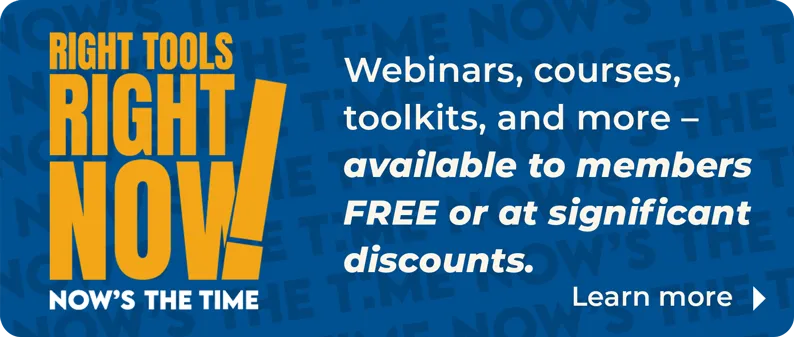
As a REALTOR® association executive, you know that member satisfaction is crucial to the success of your organization, but with tight budgets, the idea of measuring member satisfaction can feel overwhelming. Happily, with the right approach, you can gather valuable insights without breaking the bank. Understanding your goals and paying attention to a few key design points will help you measure member satisfaction effectively and efficiently.
Quantitative Versus Qualitative Research
Before diving into specific “how-to’s,” it’s essential to differentiate between quantitative and qualitative research methods and which to use when. Quantitative research—think surveys—answers questions like “what,” “when,” “how” and “how much.” It’s about measuring specific aspects of member satisfaction to gather numbers you can then analyze, quantify and draw conclusions from.
On the other hand, qualitative research—like individual interviews and focus groups—delves deeper into the “why” behind member opinions and behaviors, providing a richer understanding of their experiences. If you are at sea about why your members are satisfied or dissatisfied—or how a new service might affect that—it’s an excellent idea to talk directly to them via qualitative research to really understand what they’re thinking. Qualitative research is also wonderful for when you know you need to make a decision, but you’re not actually sure what you need to measure to make that decision.
In a perfect world, all research starts with qualitative research to make sure you’re asking the right questions in the first place. But while qualitative research offers valuable insights, it usually costs money. You’ll likely need to pay most members to attend interviews or focus groups, even via Zoom. So, if budget constraints are a significant concern, focusing on quantitative research—i.e., a survey—may be the most practical approach.
A Survey Approach
The greater the business impact of the decisions you’re making based on research, the more you should spend on research professionals to get reliable data. But if you need to measure member satisfaction quickly on a low budget, there are several steps to take before you even start thinking about writing survey questions:
- Know what you’re going to do with the data. The information you get back needs to be actionable. In this scenario, perhaps you know that you have a certain amount of money to spend amplifying the program driving the most satisfaction. You’re going to use this survey to help you figure out what that program is.
- Put together a research objective. A research objective should be very clear and simple: “To determine or measure X in order to Y.” Here, the objective could be “to measure member satisfaction with our services right now in order to amplify one program that will increase the value proposition of our membership the most.”
- Decide on the research questions. These are not the survey questions but the overall “burning questions” you need answered in this survey. Here, those could include: “How satisfied are members now with their membership?” and “Which of my association’s services are my members aware of?”
- Write testable hypotheses. Remember that a survey is a research project, and in research, you need hypotheses to be proved or disproved. Hypotheses are found either true or false based on the data you collect. Throw out some possible answers to your research questions, and you will have your hypotheses. If one of your research questions is “Which of my association’s services are my members aware of?” then one answer might be, “Most of my members are aware of our new member orientations but not of our advocacy work.” You can now write questions that will test that hypothesis and show it to be either true or false.
How to Write Great Survey Questions
Now you’re ready to write your survey questions. The most basic questions to measure member satisfaction are:
- "How satisfied are you with your membership overall?” Ask this as your first question to ensure that nothing else in the survey biases respondents’ top-of-mind answers. For the answer to this question, use a scale with an uneven number of responses. This allows people to have a neutral response—which they might. For example, on a scale of 1 to 5, 3 should be “neutral.” Make sure to label your scale so members understand, for instance, that 1 is “not at all satisfied” and 5 is “very satisfied.” Also use a survey software that weights your scales automatically so that you can get a mean rating. That will help you understand the “typical” or “overall” member response as well as how many are satisfied or dissatisfied.
- "What is the main reason for this?” Follow that satisfaction question with a comment box. You’ll be able to glean at least some of the “why” from lining up those comments against the ratings and seeing what patterns arise.
- "Which of the following member benefits were you aware of prior to this survey?” Give members a list of all the benefits you offer. Make sure to include a “none of these” option. Seeing what comes in at the top and bottom of the responses is guaranteed to be eye-opening.
- "Which of these benefits have you ever used?” If your software allows it (and it’s best to invest in one that does), offer respondents a specific list ONLY of the benefits they were aware of in the previous question. They won’t have used what they don’t know about. Again, make sure to include “none of these” as a response.
- "How valuable to your business are the following benefits?” Offer a list only of the benefits a respondent says they’ve used and ask them to rate those. It’s generally more worthwhile to know the value placed on something by those who actually use it rather than theoretical value from people who haven’t (and who may not completely understand it).
- "How likely are you to recommend membership in this association/board to other real estate professionals?” This is what is known as a net promoter score, or NPS. It is a generally accepted measurement for all kinds of products, services, events and organizations. But for you to be able to compare your results to those of other organizations, you need to set the question up in an extremely specific way.








